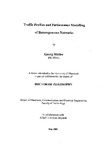Traffic Profiles and Performance Modelling of Heterogeneous Networks
| dc.contributor.author | Müller, Georg | |
| dc.contributor.other | School of Engineering, Computing and Mathematics | en_US |
| dc.date.accessioned | 2013-10-25T09:08:16Z | |
| dc.date.available | 2013-10-25T09:08:16Z | |
| dc.date.issued | 2000 | |
| dc.identifier | NOT AVAILABLE | en_US |
| dc.identifier.uri | http://hdl.handle.net/10026.1/2364 | |
| dc.description.abstract |
This thesis considers the analysis and study of short and long-term traffic patterns of heterogeneous networks. A large number of traffic profiles from different locations and network environments have been determined. The result of the analysis of these patterns has led to a new parameter, namely the 'application signature'. It was found that these signatures manifest themselves in various granularities over time, and are usually unique to an application, permanent virtual circuit (PVC), user or service. The differentiation of the application signatures into different categories creates a foundation for short and long-term management of networks. The thesis therefore looks from the micro and macro perspective on traffic management, covering both aspects. The long-term traffic patterns have been used to develop a novel methodology for network planning and design. As the size and complexity of interconnected systems grow steadily, usually covering different time zones, geographical and political areas, a new methodology has been developed as part of this thesis. A part of the methodology is a new overbooking mechanism, which stands in contrast to existing overbooking methods created by companies like Bell Labs. The new overbooking provides companies with cheaper network design and higher average throughput. In addition, new requirements like risk factors have been incorporated into the methodology, which lay historically outside the design process. A large network service provider has implemented the overbooking mechanism into their network planning process, enabling practical evaluation. The other aspect of the thesis looks at short-term traffic patterns, to analyse how congestion can be controlled. Reoccurring short-term traffic patterns, the application signatures, have been used for this research to develop the "packet train model" further. Through this research a new congestion control mechanism was created to investigate how the application signatures and the "extended packet train model" could be used. To validate the results, a software simulation has been written that executes the proprietary congestion mechanism and the new mechanism for comparison. Application signatures for the TCP/IP protocols have been applied in the simulation and the results are displayed and discussed in the thesis. The findings show the effects that frame relay congestion control mechanisms have on TCP/IP, where the re-sending of segments, buffer allocation, delay and throughput are compared. The results prove that application signatures can be used effectively to enhance existing congestion control mechanisms. | en_US |
| dc.description.sponsorship | AT&T (UK) Ltd, England | en_US |
| dc.language.iso | en | en_US |
| dc.publisher | University of Plymouth | en_US |
| dc.title | Traffic Profiles and Performance Modelling of Heterogeneous Networks | en_US |
| dc.type | Thesis | |
| dc.identifier.doi | http://dx.doi.org/10.24382/4709 | |
| dc.identifier.doi | http://dx.doi.org/10.24382/4709 |
Files in this item
This item appears in the following Collection(s)
-
01 Research Theses Main Collection
Research Theses Main


